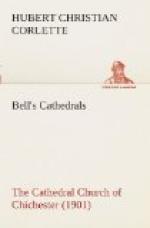The outer wall of the choir aisle is one of the most interesting portions of the building, from an archaeological as well as an architectural standpoint. It shows three of the arched heads of small twelfth-century windows that used to light the earlier triforium gallery. One of these has now a fifteenth-century insertion beneath it. This is in the second bay from the transept. It is a small window with a cusped head and a square label-mould above it. In the same area of walling there are shown the levels of the cut string-course that ran along under the sills of the twelfth-century aisle windows. It is the same string and at the same level as it appears upon the south-west angle of the transept and the south-west tower of the west front. It shows, too, in the second bay, the level of the old abaci which ran across from each capital in the window jambs and stopped against the sides of the buttresses. There is also the continuous chamfer course that ran along the walls above the heads of these aisle windows. In proof of these things there is even now one of these same old windows in almost its original state within the little chamber known as the priest-vicars’ vestry. This window is in the bay of aisle walling immediately against the transept wall. The string-courses of the old windows were continued round the later buttresses. In the fourth bay, above the point of the window arch, the curve of the original apse of the ambulatory is just traceable; but beyond this point eastwards the twelfth-century walling has disappeared until we meet it again in the lady-chapel. There is a small buttress in the fourth bay marking the junction between the two periods of masonry. In the second and third bays part of the twelfth-century top to the aisle walls remains. The roof may have had eaves originally, but now there is a parapet of about the same date as the present buttresses; and the projection of this parapet is carried upon the corbels that were carved and built in before the second fire occurred. The space between each corbel is bridged over by small single stones cut out to the shape of a semicircular arch.
The windows in the second, third, and fourth bays differ in size and shape from each other; that in the second bay has a pointed arch and no tracery, square abaci and the remains of carved capitals. The angle shafts and bases are gone. They were all inserted at about the same time; but that in the third bay has had some poor modern tracery without cusps added to it, and that in the fourth bay is a more recent, insertion than the one next to it. In the third and fourth bays just above the low chamfered base of the wall are three semicircular markings cut on the wall, but there is nothing to explain their existence. In the fourth bay close beneath the sill of the window is a stone built into the wall, upon which a dedication cross is cut. At the fifth bay the east walk of the cloisters joins the wall of the aisle; its roof partly hides a window,




